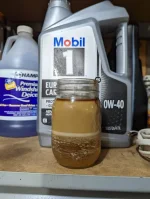I have a GMC truck with a GDI 6.6L gas engine.
I put a catch can on it to separate the oil vapors.
GM said they redesigned the PCV system to take out the oil. I'd say that it works.
In 3,000 miles I have very little oil. Just water.
I'm using Valvoline 5w30EP if that matters.
I put a catch can on it to separate the oil vapors.
GM said they redesigned the PCV system to take out the oil. I'd say that it works.
In 3,000 miles I have very little oil. Just water.
I'm using Valvoline 5w30EP if that matters.

